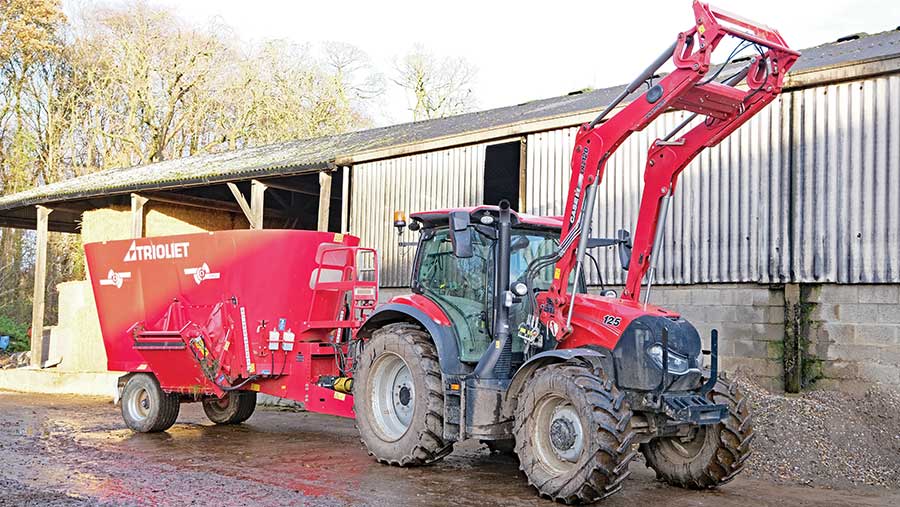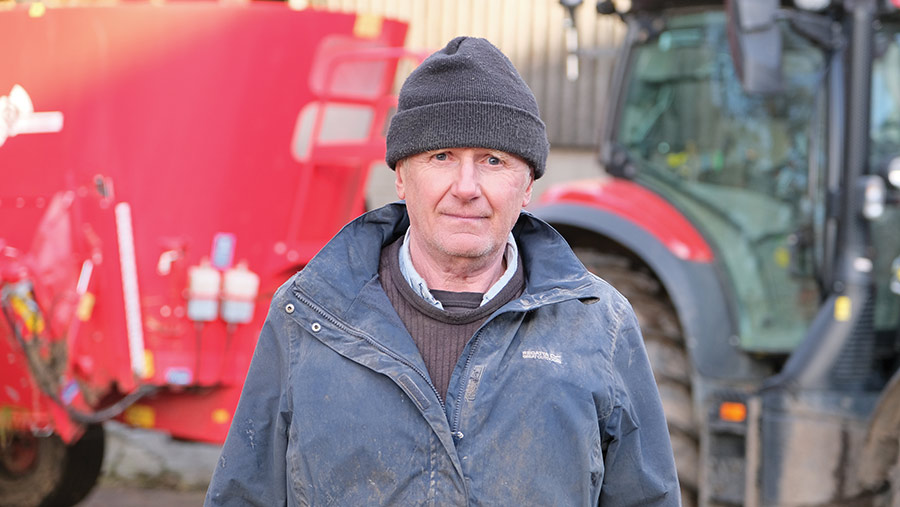Driver’s view: Case IH Maxxum 125 ActiveDrive 4 tractor
 Case Maxxum 125 © James Andrews
Case Maxxum 125 © James Andrews A recent reordering of Case IH’s smaller tractor ranges has resulted in a slimming down of the popular Maxxum series to a trio of models.
But with three transmission options on the table and the choice of four- or six-cylinder engines, there’s still plenty of scope for customisation.
See also: On test: Case’s double-clutch gearbox in the 145hp Maxxum
Buyers looking for a simple loader tractor are catered for by the entry-level Maxxum 125, which is powered by a 4.5-litre FPT engine developing a maximum power of 135hp.
David Evans’ Case IH Maxxum 125 specs
- Engine 4.5-litre, four-cylinder FPT
- Max power 135hp (155hp with boost)
- Transmission Four-range, four-speed ActiveDrive 4
- Hydraulics 150 litres/min
- Rear lift capacity 7,115kg
- Price paid £67,000

David Evans © James Andrews
And the base transmission for this tractor is the no-frills ActiveDrive 4 semi-powershift, featuring four mechanical ranges with four splitters in each.
It’s this model that appealed to pedigree Aberdeen Angus producer David Evans of Tree Bridge Angus, who farms in partnership with his wife, Penny, near Middlesborough.
We caught up with him as the tractor was edging into its third season, with the clock registering 800 hours of work.
Why a Case IH Maxxum 125 ActiveDrive 4?
Our last loader tractor was a Farmall 115U and, although it had been great for most jobs, it wasn’t physically big enough to handle some of our larger equipment.
This included hauling 12t loads of silage (sometimes larger if we needed to pull one of our contractor’s trailers), carting bales back to the yard and running a 16cu m twin-tub Trioliet 2-1600 mixer wagon.
We only have one tractor and we like to change it every five or six years, so when the Farmall’s time was up we traded it in with our local dealer, Paxtons, and jumped up to the Maxxum range.
Complexity was something we didn’t need, so we chose the simplest ActiveDrive 4 semi-powershift transmission and kept the number of optional extras to a minimum.
What extras did you opt for?
As standard, the tractor came with three rear spool valves, but we increased this to four so that we had plenty of capacity for running kit such as the mixer wagon.
A loader was also added – a Case IH-branded LRZ120 – which came with boom suspension and hydraulic pins in the headstock.
We rarely take the loader off, so the boom damping makes a massive difference when driving at speed, and the hydraulic pins are a must in my view – who on earth wants to keep hopping off the seat every time you need to change an attachment?
How has it performed?
It might be the highest-horsepower tractor we’ve ever had, but we’re still impressed with the power output and how stable it is with larger implements fitted.
Other things that stand out are the spacious cab, with simple controls and good suspension, the roof window that lets you see the loader at full height and the large two-part mirrors.

© James Andrews
The bottom section of these is great for seeing what’s going on low down, and they’re particularly handy for keeping an eye on the rear wheels when navigating through buildings and narrow gateways.
The LED work lights are a real bonus when working at night.
There haven’t been any significant breakdowns in its first 800 hours, other than a couple of dodgy sensors.
Any room for improvement?
It’s obviously a bigger tractor than our old Farmall, but the poor turning circle makes it far clumsier than it should be around the yard. This is particularly noticeable when we’re trying to manoeuvre the mixer wagon.
Another painful oversight is the design of the closing handle for the one-piece door. It is positioned too near the hinge, which makes it annoyingly stiff to operate, so I tend to grab the rail on the door instead.
The only problem with this is that it traps your fingers against the passenger seatbelt rail. There’s also no handle on the front pillar for passengers to grab on to.
One extra that we might be tempted by next time is an electric rather than cable-operated joystick for the loader.
Like and gripes
Likes
- Stable
- Spacious cab with good visibility
- Simple to operate
- Reliable
Gripes
- Poor turning circle
- Door handle can trap fingers
- No grab handle for passengers

